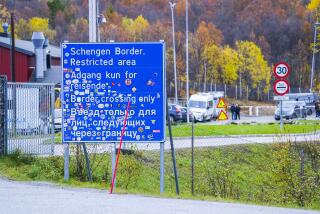Scandinavia, Russia Split by Silver Curtain
- Share via
MURMANSK, Russia — For the Kola Peninsula, the Iron Curtain was brought down only to have a Silver Curtain close in its place.
It marks the chasm of wealth that splits Europe’s Arctic between poor and chaotic Russia and the wealthy, orderly Nordic states.
Since the collapse of the Soviet Union, the West’s Cold War fears of nuclear attack from the Kola have been replaced by anxiety about the spread of atomic radiation, industrial pollution, disease and social unrest.
The peninsula, about 500 miles north of St. Petersburg and on the Barents Sea, is home to pristine forest, stark tundra and strategically located military harbors.
Offering the Russian navy a sea corridor to the North Atlantic, it is the only place where Russia borders the European Union, at neutral Finland, or NATO, at Norway.
Few frontiers have a greater contrast in living standards. Finns and Norwegians earn perhaps 30 times more than their Kola neighbors and have generous education, health and welfare services.
Good jobs dried up on the Kola with the decrease in Russian military spending after the Cold War.
In an outdoor market, Fiina Torchinkova ekes out a living by selling shoes. “I make enough to buy a piece of bread, and maybe butter if I am lucky,” she says.
As the base for the once-powerful Russian North Fleet, the Kola still is home to 155 nuclear submarines, although 71 of them are derelict. And it has eight nuclear-powered icebreakers.
It is those deteriorating vessels that have the peninsula’s Western neighbors worried. In 1996, a report by the Norwegian environmental group Bellona said about two-thirds of the nuclear waste ever dumped in the world’s oceans lies off the Kola.
Norway, the world’s second largest oil exporter, has spent about $21 million on Kola environmental projects. The European Union and the United States also are involved in similar projects.
Nordic countries, notably Norway, are augmenting environmental projects with programs to shore up the Kola’s collapsed health and social services.
“The challenge is to show the public, not in the least on the Kola, that some progress is being made,” said Geir Hunneland, a Norwegian expert on the Kola.
For peninsula residents, immediate survival overshadows long-term dangers from radiation and pollution. Even those with jobs often don’t get paid. And there is little of a social safety net for those without work.
Life on the tundra can be extremely harsh. Some homes lack heat on minus-40-degree winter nights. There are few jobs, money for food is short, and medicine often is unavailable.
Life expectancy has plunged to 47 for men and 48.9 for women. That’s about 30 years less than their Nordic neighbors.
About 125 miles to the east of Murmansk, a rough road ends at the village of Lovozero. There, Europe’s largest and most pristine wilderness stretches south to the shores of the White Sea.
Murmansk, on a long bay near the middle of the Kola, is the biggest city anywhere in the Arctic. Its 500,000 people are a reminder of the days when Soviet rulers sent thousands of soldiers, miners and others to the peninsula, pushing the population from a few thousand to more than a million.
Nearly 10% of the Kola’s population has deserted the area over the last five years, and many more would go if they could.
An increasing number of those stuck on the Kola take cheap bus junkets to nearby Norway, Sweden and Finland, often to sell trinkets or smuggled alcohol and tobacco, engage in prostitution or--merchants charge--to shoplift.
Norwegian health officials, among others, fear the spread of diseases like cholera--which is considered eradicated in the Nordic countries but which hit the Kola over the winter.
“We are especially concerned about the new and reemerging diseases that threaten the public health situation in Europe,” said Norway’s deputy foreign minister, Aaslaug Haga.
More to Read
Sign up for Essential California
The most important California stories and recommendations in your inbox every morning.
You may occasionally receive promotional content from the Los Angeles Times.













